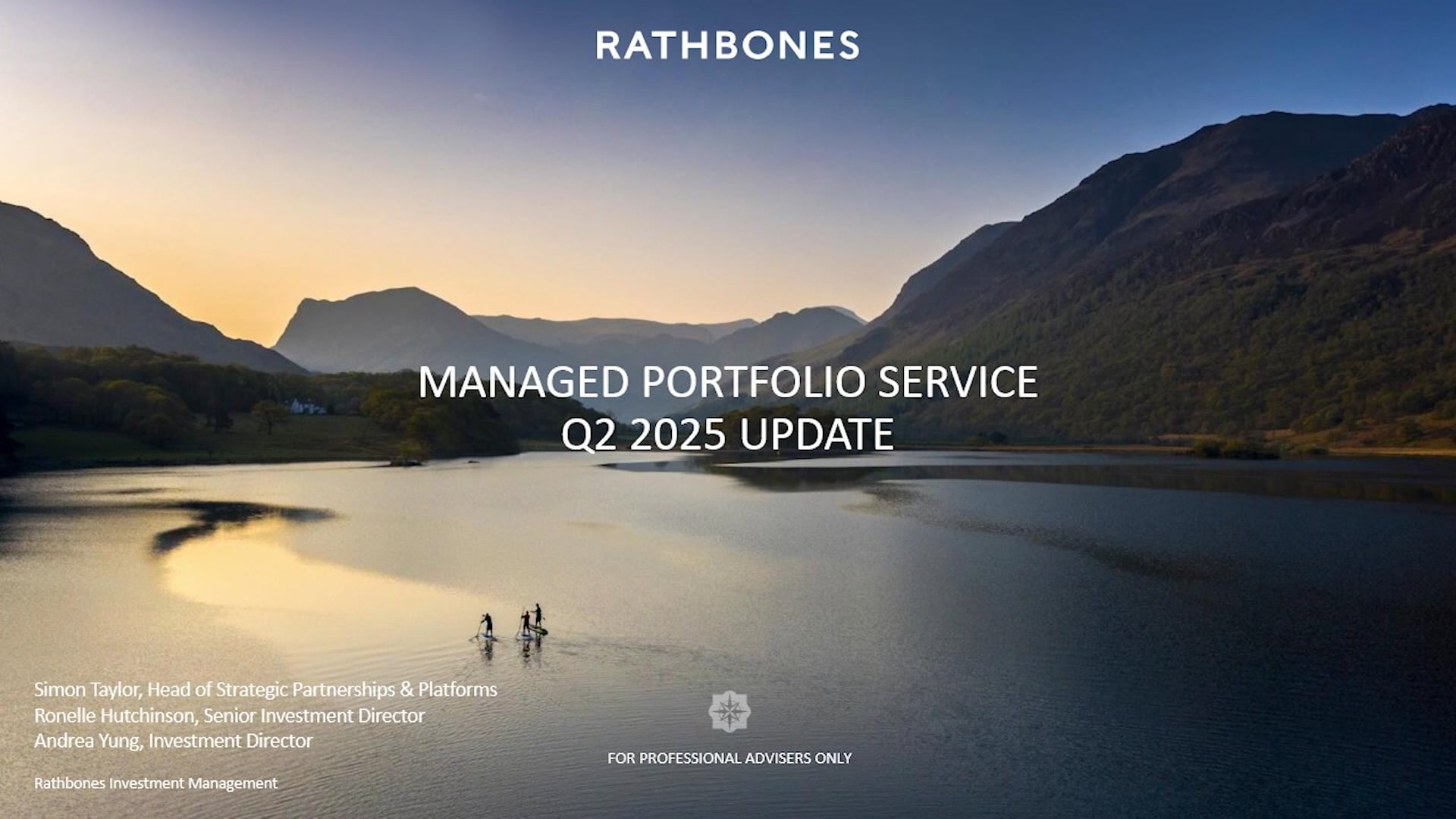Simon Taylor: Hello, good morning, and welcome to our Q2 Managed Portfolio Service webinar.
Over the past quarter, markets have continued to navigate sticky inflation, shifting rate expectations, and increasing political uncertainty. These factors have all shaped asset class behaviour and informed our positioning across portfolios.
Today, Ronelle will start with a summary of the macroeconomic and market backdrop — covering inflation trends, central bank activity, and investor sentiment. Then Andrea will take us through how this has influenced our portfolio positioning and performance over the quarter.
Looking ahead, we’re also working on a range of enhancements to the MPS proposition — drawing on the combined expertise of our recently merged investment management businesses. These developments are aimed at helping investors better navigate an increasingly volatile world, while further improving both the investment experience and long-term returns.
More about that later, now I’ll hand over to Ronelle to begin with the macro-overview.
Ronelle Hutchinson: Year to date markets appear to have shrugged off the tariff uncertainty and geopolitical risk to climb to new highs in June. What’s uniquely different this year is the extent to which international Equities have dramatically outperformed the US. Europe is up +12.5%, the UK up 9% vs the S&P 500 which is down 3%, all in pounds Part of this outperformance is due to the weakness of the U.S. dollar, with the dollar ending the first half down approximately 10%. Commodities on the other hand have performed well with gold up over a 13% providing a buffer to the trade tensions, inflationary risk, and geopolitical challenges that we’ve seen this year.
Despite the Trump administration’s willingness to negotiate on tariffs, moderating the Liberation Day effective tariff rate, uncertainty on trade policy remains. This is expected to weigh on the growth outlook for the US given the likely negative impact on prices, costs, margins and supply chains. What we show in the chart is the US Federal Reserve economic forecasts which have been updated in June, as you can see growth in GDP has been dialled back since March. While we do expect one big, beautiful act that has just passed to have a positive effect on growth in the short term, adding about 0.2% to GDP, the substantial increase in Debt of over $3.3tn over 10 years is likely weigh on longer-term interest rates and crowd out investment. Thus, the weaker economic backdrop combined with expensive US valuations at 22x earnings and a re-acceleration in analysts’ earnings expectations going into 2026 heighten the risk of disappointment in US equities. Hence, we remain slightly underweight.
Moving to the UK, while the local market has cheap valuations and an attractive dividend yields growth outlook is weak, and with elevated inflation the recent CPI print came in at 3.6% above expectations, and rising taxes amidst fiscal risks keep us retaining our neutral position to local equities.
One of the reasons the US economy has been so exceptional is due to the government’s willingness to take on much more debt to stimulate the economy. Trump on the other hand, has spurred Germany and the EU to act to take control of its destiny with enormous funds created for defence and infrastructure spending, which we expect to be more positive for European growth. Europe in the last couple of years is coming off a low growth base and with falling interest rates and lower inflation. We are beginning to see some early signs of green shoots in the economic data, which coupled with fiscal expansion is structurally positive. Also, European valuations are undemanding, and price momentum remains positive. As a result, we are preferring to be overweight Europe.
Shifting asset cross correlations now pose a challenge for multi-asset portfolios. The negative correlation between equity and bond returns which held pretty much through the early 2000’s appears to have now firmly reversed with both assets moving somewhat together, in an apparent return to the ‘old normal’ illustrated in the 80’s and 90’s on this chart. This poses a challenge for portfolio construction as adequate diversification can no longer be achieved simply through a simple mix of equities and longer-date bonds. In fact, when you look at this year’s equity market selloff, longer-dated US Treasuries didn’t provide much buffer. For us this reiterates the importance of diversifying assets and having exposure to alternatives given the fiscal loosening that’s taking place, inflation risks & geopolitical uncertainty.
Moving into the second half of the year, we remain defensively positioned, we remain marginally underweight US equities. The drivers of this is our expectations of weaker US growth in the second half, we also continue to be overweight European equities, leaning into the improved outlook in the region owing to fiscal spending and lower interest rates. Valuations are also undemanding which supports this view. We have maintained our exposure to alternatives but have enhanced protection focusing on relative value strategies to limit portfolio volatility and drawdown risk. We remain overweight fixed income, but we have shorter duration vs. the benchmark given the higher levels of bond volatility.
I’ll now hand over to Andrea to provide an update on the portfolio positioning and performance over the quarter.
Andrea Yung: So, reflecting on the key changes that we have made over the quarter. Firstly, we have reduced our property allocation, our exposure here was highly weighted to the US and therefore closely tied to the performance of the US economy. With an expected slowdown in growth, and trade tariffs creating potentially higher inflation, we wanted to reduce our exposure to these particular headwinds.
Instead, we have aimed to enhance protection of the portfolio by adding exposure to absolute return strategies that are designed to deliver positive returns in all market conditions. The low-risk nature of this type of strategy, will help to support downside protection especially because we do expect to see continued volatility in markets over the second half of the year, this should help to support a smoother return profile.
Finally, we have increased our European exposure across our range. This has been motivated by the changes we have seen in European fiscal policy and the support for defence spending. This dramatic shift in approach suggests the outlook for European growth over the next few years has improved. Despite the headwinds from US tariffs, changes in momentum and attractive valuations, creates a more favourable outlook for European equities.
So what does that mean for our overall model positioning? Well, focusing on our Equity breakdown, we remain Underweight US – in line with our concerns around the region, trade tariffs and slowing growth. We are overweight in Europe – enhanced Fiscal stimulus, lower interest rates and attractive valuations have supported our decision be overweight in this region. We continue to maintain an overweight position in Japanese equities, supported by broad-based earnings momentum across a wide range of companies. The rise in share buybacks also further signals growing corporate confidence in the region.
If we delve deeper into our Equity analysis, we continue to hold blended exposure to Value and Growth Assets. What we have done so far this year, is dial back the growth tilt that we had in the portfolio at the end of last year. This is on the back of growing vulnerabilities we were seeing in the magnificent-7 stocks within the US. What this year has shown to us already, is the potential volatility that can occur and being overly exposed to these types of mega cap stocks it reaffirms that importance of diversification across styles and sectors.
We continue to take an active approach to investing with around 70% of our portfolio is invested in active funds. This strategy provides the flexibility to adjust positioning in response to evolving economic and geopolitical conditions, supporting effective risk and volatility management across the portfolio.
Turning to performance, it has been another volatile period for markets this quarter. The start of the quarter saw significant volatility on the back of US tariffs concerns, with Liberation Day causing a sharp sell-off. However, as we moved into the quarter a strong earnings season really helped to boost mega cap-tech stocks in the last couple of months. We saw global growth stocks being the strong outperformer here, with May and June being a really positive period for equity investors. Our tilt away from growth assets, provided somewhat of a headwind, however, we are pleased to have kept pace with the wider peer group.
And if we take a slightly longer-term view, looking at our performance over 1 year. You can see that we have managed this heightened volatility well, outperforming the ARC peer group. The broadening out that we have seen in market returns, especially since the start of the year, have been supportive for our strategies, that are well diversified and actively managed. Taking a longer-term view, looking at performance since inception, our portfolios outperformed their peer group across our full range. We continue to take a long-term approach to investing, with a focus on downside protection which helps to smooth out our returns and support long-term performance.
Simon Taylor: Thank you, Ronelle, for that overview on markets and Andrea for the overview of what’s been going on in portfolios. We have got a few questions from our advisers which I’ll pick up and get your responses on.
Ronelle, how are we ensuring that there is regional diversification in our MPS portfolios?
Ronelle Hutchinson: Since the start of 2025, we’ve seen that there has been a real divergence in performance with regions like Europe, the UK and China outperforming the US. Our asset allocation committee which takes a forward looking approach to markets, has judged that the risk-reward profile for the regions outside of the US is actually much more favourable. As a result, we’re overweight Europe, we are overweight Japan, we are neutral on UK equities and we’re slightly underweight US equities. From a portfolio perspective, how we ensure that this view is reflected in portfolios, we use all of our internal and external risk tools to ensure that from a regional perspective, our positioning relative to the benchmark reflects these views in the portfolio.
Simon Taylor: What sort of enhancements can we expect as a result of the merger between Investec and Rathbones and the two management teams?
Andrea Yung: So, the idea here is bringing the best of both worlds. With this new enhanced MPS proposition, you’ve got the expertise and experience from the Rathbones multi-asset team, and you’ve got the expertise and experience from the MPS management team from Investec. What we’ve done is we’ve tried to identify common issues that we’ve seen with this type of MPS on platforms solution, whether that’s lack of platform availability, whether that’s issues with rebalancing and we’ve tried to create a solution to tackle these issues. With this building block solution that we’ve got, we hope that it will provide an attractive, active solution that will provide a better outcome to clients.
Simon Taylor: Brilliant, so advisers can expect to hear more from us in the coming weeks and months about how we’re going to implement that in portfolios?
Andrea Yung: Yes, exactly, we’ll have all the information advisers will need in order to understand the changes that we’re making and how we feel this will be a much better solution.
Simon Taylor: This year ARC launched some indices specific to MPS portfolios, how are our portfolios standing up against that new benchmark?
Andrea Yung: ARC have created this new MPS indices, they’ve tried to capture performance which is more specific for MPS solutions, they’ve captured data from 750 different solutions, 60 different providers so it does show you that it’s capturing that MPS market. We’re pleased to see that since inception across the full range we have been able to outperform.
Simon Taylor: That concludes the questions that we have received from advisers this month. I’d like to thank you for your time today. I’d also like to remind you, please reach out to your business development directors if you have got any other questions that you’d like to ask us or please use the email that’s on the bottom of the screen to pose them for next quarter. Thank you for your time today, we look forward to seeing you in the future.




